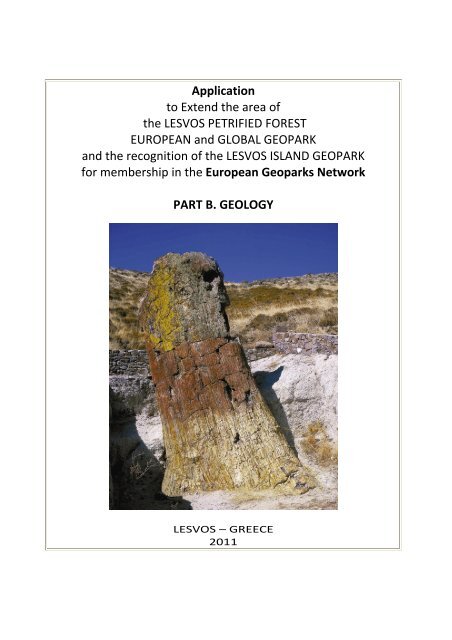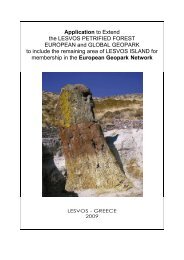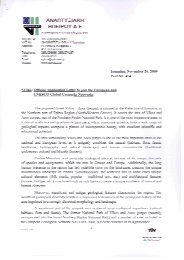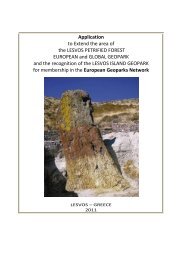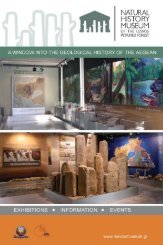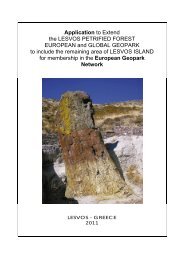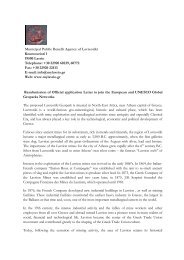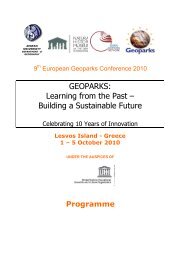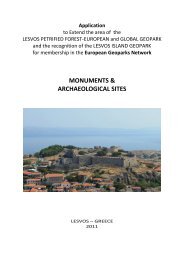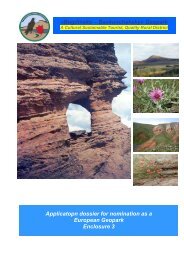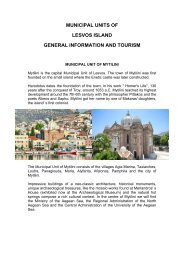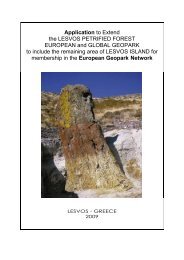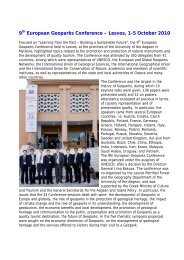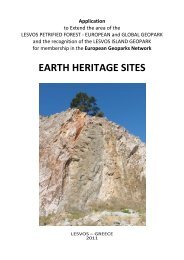Application to Extend the area of the LESVOS PETRIFIED FOREST ...
Application to Extend the area of the LESVOS PETRIFIED FOREST ...
Application to Extend the area of the LESVOS PETRIFIED FOREST ...
Create successful ePaper yourself
Turn your PDF publications into a flip-book with our unique Google optimized e-Paper software.
<strong>Application</strong><br />
<strong>to</strong> <strong>Extend</strong> <strong>the</strong> <strong>area</strong> <strong>of</strong><br />
<strong>the</strong> <strong>LESVOS</strong> <strong>PETRIFIED</strong> <strong>FOREST</strong><br />
EUROPEAN and GLOBAL GEOPARK<br />
and <strong>the</strong> recognition <strong>of</strong> <strong>the</strong> <strong>LESVOS</strong> ISLAND GEOPARK<br />
for membership in <strong>the</strong> European Geoparks Network<br />
PART B. GEOLOGY<br />
<strong>LESVOS</strong> – GREECE<br />
2011
Geological Heritage <strong>of</strong> Lesvos Island<br />
Abstract<br />
Lesvos island belongs <strong>to</strong> <strong>the</strong> Pelagonian geotec<strong>to</strong>nic zone <strong>of</strong> Greece. The geological structure<br />
<strong>of</strong> Lesvos Island comprises:<br />
� The Permo‐Triassic metamorphic basement, including schists, quartzites,<br />
metasands<strong>to</strong>nes, phyllites, marbles and crystalline carbonates.<br />
� An ophiolitic sequence (basic and ultrabasic rocks, deep‐sea sediments and<br />
metamorphic rocks <strong>of</strong> <strong>the</strong> sole), overthrusted <strong>the</strong> metamorphic basement.<br />
� Tertiary volcanic rocks and Neogene marine and lacustrine deposits, as well as<br />
Quaternary deposits.<br />
The Neogene volcanic rocks, dominate <strong>the</strong> Central and Western part <strong>of</strong> <strong>the</strong> island and are<br />
associated with <strong>the</strong> presence <strong>of</strong> remains <strong>of</strong> fossil plants, which form <strong>the</strong> famous «Petrified<br />
forest <strong>of</strong> Lesvos», declared as Protected Natural Monument. It was developed during Late<br />
Oligocene <strong>to</strong> Lower ‐ Middle Miocene, due <strong>to</strong> <strong>the</strong> intense volcanic activity in <strong>the</strong> <strong>area</strong> which<br />
created impressive volcanic geosites. Neotec<strong>to</strong>nic activity also contributed <strong>to</strong> <strong>the</strong> morphology<br />
<strong>of</strong> <strong>the</strong> island forming significant tec<strong>to</strong>nic fault scarps associated with strong earthquakes.<br />
2
B. Geological Heritage<br />
1. Location <strong>of</strong> <strong>the</strong> proposed Lesvos Geopark<br />
The island <strong>of</strong> Lesvos is located in <strong>the</strong> NE Aegean Sea. During Cenozoic, Lesvos <strong>to</strong>ok its present<br />
impressive shape which <strong>the</strong> Nobel prize poet Elytis likened <strong>to</strong> <strong>the</strong> leaf <strong>of</strong> a plane tree. On <strong>the</strong><br />
extreme Western edge <strong>of</strong> <strong>the</strong> island on an <strong>area</strong> <strong>of</strong> incomparable wild beauty, appear large<br />
accumulations <strong>of</strong> fossilised tree trunks comprising <strong>the</strong> well known «Petrified Forest <strong>of</strong> Lesvos»,<br />
The glossiness and <strong>the</strong> chromatic variety <strong>of</strong> <strong>the</strong> petrified pieces is fascinating. On Megalonisi,<br />
<strong>the</strong> island which protects <strong>the</strong> bay <strong>of</strong> Sigri, lie some marvellous trunks <strong>of</strong> petrified trees.<br />
The protected <strong>area</strong> <strong>of</strong> <strong>the</strong> Petrified Forest (15.000 ha) declared as Protected Natural Monument,<br />
is a founder member <strong>of</strong> <strong>the</strong> European Geoparks Network (2000) and is included in <strong>the</strong> Global<br />
Geoparks Network in 2004.<br />
The new application includes <strong>the</strong> already recognized Lesvos Petrified Forest Geopark and <strong>the</strong><br />
remaining 148.000 ha <strong>of</strong> <strong>the</strong> <strong>to</strong>tal surface <strong>of</strong> <strong>the</strong> island.<br />
2. General geological description <strong>of</strong> <strong>the</strong> proposed Lesvos Geopark<br />
Lesvos island belongs <strong>to</strong> <strong>the</strong> Pelagonian geotec<strong>to</strong>nic zone <strong>of</strong> Greece which represents fragment<br />
<strong>of</strong> <strong>the</strong> Cimmerian Continent (Mountrakis 1983; 1992).<br />
The geology <strong>of</strong> Lesvos has been described by Hecht (1971; 1974; 1975), Pe‐Piper (1978),<br />
Katsikatsos et al. (1982, 1986). Hecht (1971;1974) presented <strong>the</strong> geological map <strong>of</strong> <strong>the</strong> island (1:<br />
50.000 scale). Chemical analyses <strong>of</strong> <strong>the</strong> volcanic rocks have been carried out by Georgalas<br />
(1949), Borsi et. al. (1972), Pe‐Piper (1978; 1980; 1984) and Pe‐Piper and Piper (1980; 1989;<br />
1997).<br />
Geological Map <strong>of</strong> Lesvos Island<br />
3
According <strong>to</strong> <strong>the</strong> published data <strong>the</strong> geological structure <strong>of</strong> Lesvos Island comprises <strong>the</strong><br />
following rock‐units.<br />
• An au<strong>to</strong>chthonous unit <strong>of</strong> Permo‐Triassic age, including schists, quartzites,<br />
metasands<strong>to</strong>nes, phyllites with intercalation <strong>of</strong> marbles and crystalline carbonates.<br />
These rocks are widely extended on <strong>the</strong> Sou<strong>the</strong>ast part <strong>of</strong> <strong>the</strong> island, while in <strong>the</strong><br />
Northwest part <strong>the</strong>y have a ra<strong>the</strong>r small extension.<br />
• The allochthonous units that represent remnants <strong>of</strong> an ophiolitic sequence, comprising<br />
basic and ultrabasic rocks and associated deep‐sea fine‐grained sediments, as well as<br />
metamorphic rocks, amphibolites and amphibole schists, metabasites and<br />
metasediments, parts <strong>of</strong> <strong>the</strong> sole, overthrusted <strong>the</strong> metamorphic basement. These<br />
alpine and pre‐alpine rocks were later covered by Tertiary volcanic rocks and Neogene<br />
marine and lacustrine deposits, as well as Quaternary deposits. The Neogene volcanic<br />
rocks, dominate <strong>the</strong> Central and Western part <strong>of</strong> <strong>the</strong> island.<br />
The Metamorphic basement<br />
The au<strong>to</strong>chthonous unit, according <strong>to</strong> Katsikatsos et al. (1982,1986), is a series <strong>of</strong> formations<br />
ranging from Neopaleozoic <strong>to</strong> Upper Triassic age. It has no strati‐graphic unconformities and it<br />
consists entirely <strong>of</strong> metaclastic rocks, crystalline limes<strong>to</strong>nes and dolomites. It is characterised by<br />
a very low grade metamorphism.<br />
These rocks dominate on <strong>the</strong> Sou<strong>the</strong>ast part <strong>of</strong> <strong>the</strong> island, where <strong>the</strong> visible thickness, in places,<br />
is more than 1.000 m. In <strong>the</strong> Northwest part <strong>of</strong> <strong>the</strong> Island <strong>the</strong>y have relatively small extension<br />
(<strong>area</strong>s <strong>of</strong> Sigri, Gavathas, Eressos) and <strong>the</strong>y are exposed under <strong>the</strong> postalpine volcanic rocks and<br />
lacustrine deposits.<br />
The metamorphic rocks consist <strong>of</strong> schists (mainly micaceous, sericitic and chlo‐ritic) alternating<br />
with metasands<strong>to</strong>nes (mainly arkoses), and quartzites as well as lenses and intercalations <strong>of</strong><br />
crystalline limes<strong>to</strong>nes and dolomites.<br />
Generally <strong>the</strong> extension and <strong>the</strong> thickness <strong>of</strong><br />
<strong>the</strong> carbonate rocks are always limited,<br />
except in <strong>the</strong> upper parts <strong>of</strong> certain <strong>area</strong>s,<br />
where <strong>the</strong> carbonates dominate.<br />
In <strong>the</strong>se rocks and in several localities and<br />
different stratigraphic horizons, a rich fauna<br />
<strong>of</strong> Carboniferous‐Permian age was found<br />
(Hecht 1972; 1974; 1975, Katsikatsos et al.<br />
1982) consisting <strong>of</strong> foraminifers, algae,<br />
lamellinbranches, gastropods, echinoderms,<br />
crinoids and corals.<br />
Mount Olympos<br />
The Triassic formations represent <strong>the</strong><br />
upwards normal transition <strong>of</strong> <strong>the</strong> Neopa‐<br />
leozoic formations and <strong>the</strong>y are found only in <strong>the</strong> Sou<strong>the</strong>ast part <strong>of</strong> Lesvos. They consist mainly<br />
<strong>of</strong> schists and metasands<strong>to</strong>nes. Within <strong>the</strong>se formations very thick intercalations <strong>of</strong> crystalline<br />
carbonates usually occur, where fossils <strong>of</strong> Megalodon have been found by Katsikatsos (Migiros<br />
1994). They are characterised by <strong>the</strong> presence <strong>of</strong> breccia and big carbonate blocks, mainly<br />
within <strong>the</strong>ir upper horizons.<br />
4
The Ophiolitic sequence<br />
Basic and ultrabasic rocks, associated deep‐sea sediments, as well as basic metamorphic rocks,<br />
overthrust <strong>the</strong> metamorphic basement. All <strong>the</strong>se rocks have an allochthonous origin, <strong>the</strong>y are<br />
remnants <strong>of</strong> an ophiolitic sequence and represent fragments <strong>of</strong> <strong>the</strong> Neo‐Tethyan oceanic<br />
lithosphere, which were emplaced on <strong>the</strong> Pelagonian margin during Mesozoic (Mountrakis et al.<br />
1992).<br />
According <strong>to</strong> Katsikatsos et al. (1982; 1986), <strong>the</strong> allochthonous rocks are divided in<strong>to</strong> two<br />
tec<strong>to</strong>nic nappes. The lower nappe, comprising Triassic volcano‐sedimentary formations and <strong>the</strong><br />
upper one, comprising ophiolitic rocks.<br />
The lower nappe, occupies a large <strong>area</strong> in <strong>the</strong> Sou<strong>the</strong>ast part <strong>of</strong> <strong>the</strong> island and its thickness<br />
exceeds, in places, 1.000 m. It consists <strong>of</strong> various types <strong>of</strong> metabasites, which usually dominate<br />
in <strong>the</strong> upper parts, and metasediments. At <strong>the</strong> base <strong>of</strong> <strong>the</strong> lower tec<strong>to</strong>nic nappe, crystalline<br />
limes<strong>to</strong>nes and dolomites appear forming lenses and intercalations with schists <strong>of</strong> various<br />
mineralogical composition (chlorite, mica, sericite, e.t.c.) and conglomerates. Characteristic<br />
fossils <strong>of</strong> Lower‐Middle Triassic age have been found in <strong>the</strong> carbonate rocks (Katsikatsos et al.<br />
1982).<br />
The volcano‐sedimentary rocks suffered initially a low grade metamorphism in <strong>the</strong> pumpellyite‐<br />
actinolite‐chlorite zone (Katsikatsos et al. 1982). But in some places <strong>the</strong> presence <strong>of</strong><br />
glaucophane, provides a high‐pressure metamorphism.<br />
The upper ophiolitic nappe occupies a large <strong>area</strong> in <strong>the</strong> Sou<strong>the</strong>ast part <strong>of</strong> Lesvos. Geophysical<br />
data indicate that in <strong>the</strong> central part <strong>of</strong> <strong>the</strong> island (Kalloni gulf) <strong>the</strong> ophiolites are continuous at<br />
depth below <strong>the</strong> Neogene volcanic rocks. The ophiolitic rocks overthrust, in <strong>the</strong>ir larger part, <strong>the</strong><br />
volcano‐sedimentary formations and can be divided in<strong>to</strong> two parts, which are in tec<strong>to</strong>nic<br />
relation, an upper part which mainly consists <strong>of</strong> ultramafic rocks (peridotite, pyroxen‐peridotite,<br />
and olivinite) and a lower part consisting <strong>of</strong> metamorphic basic ophiolitic rocks. Ultramafic<br />
rocks, <strong>of</strong> various degrees <strong>of</strong> serpentinization, are intersected by veins <strong>of</strong> pyroxenites and<br />
gabbros. Their thickness exceeds in places 1.000 m. Metamorphic basic ophiolitic rocks, mainly<br />
amphibolites and amphibolitic schists, are always tec<strong>to</strong>nically intercalated with <strong>the</strong> ophiolitic<br />
rocks and <strong>the</strong> underlying volcanosedimentary formations. Their thickness reaches, in places 300<br />
m.<br />
Both <strong>the</strong>se rock ‐ groups which belong <strong>to</strong> <strong>the</strong> ophiolitic tec<strong>to</strong>nic nappe have suffered at least<br />
one very low grade metamorphism in <strong>the</strong> pumpellyite‐actinolite‐chlo‐rite zone, similar <strong>to</strong> <strong>the</strong><br />
one that suffered <strong>the</strong> volcano‐sedimentary nappe (Katsikatsos et.al. 1986; Katagas & Panagos,<br />
1979).<br />
The Postalpine volcanics<br />
Neogene volcanic rocks dominate <strong>the</strong> Central and Western part <strong>of</strong> <strong>the</strong> island. Lesvos is part <strong>of</strong> a<br />
belt <strong>of</strong> late Oligocene <strong>to</strong> middle Miocene calc‐alcaline <strong>to</strong> shoshonitic volcanism <strong>of</strong> <strong>the</strong> Nor<strong>the</strong>rn<br />
and Central Aegean Sea and Western Ana<strong>to</strong>lia.<br />
In <strong>the</strong> central part <strong>of</strong> <strong>the</strong> island <strong>the</strong>re is a series <strong>of</strong> stra<strong>to</strong>volcanoes, <strong>of</strong> basalt, andesite, dacite<br />
and rhyolite, termed <strong>the</strong> main volcanic chain, which extends in a SW‐NE direction and includes a<br />
probable caldera complex near Va<strong>to</strong>ussa (Pe‐Piper 1978; 1980).<br />
5
The Oligocene‐Miocene volcanic rocks <strong>of</strong> Lesvos are shoshonitic, with only minor interbedded<br />
calc‐alkaline andesites. There was minor earlier (21.5 M.a.) and later (16.5 M.a.) calc‐alkaline<br />
volcanism. Several volcanic formations can be distinguished:<br />
• The Eressos Formation is <strong>the</strong> oldest igneous formation, composed by porphyritic<br />
andesites interbedded with agglomerate and volcaniclastic rocks, dated at 21.5 M.a., by<br />
Pe‐Piper & Piper (1993). These lavas are 3 <strong>to</strong> 4 M.a., older than <strong>the</strong> main volcanic<br />
sequence <strong>of</strong> Lesvos.<br />
• The Skoutaros Formation is a normally magnetised sequence <strong>of</strong> andesite and basalt flow<br />
approximately synchronous with Sigri pyroclastics and Polychni<strong>to</strong>s ingnimbrite. In <strong>the</strong><br />
upper part <strong>of</strong> <strong>the</strong> formation pyroxene andesite lavas interbedded with hornblende‐<br />
biotite dacite lavas and felsic pyroclastic rocks <strong>of</strong> Sigri pyroclastic Formation.<br />
• The Sigri pyroclastics, thickest in <strong>the</strong> west <strong>of</strong> <strong>the</strong> island, are connected with <strong>the</strong><br />
development <strong>of</strong> <strong>the</strong> Petrified forest and are overlain by several sheets <strong>of</strong> <strong>the</strong> Polichni<strong>to</strong>s<br />
ignimbrite. The Kapi rhyolite domes are <strong>of</strong> approximately <strong>the</strong> same age, <strong>of</strong> about 17.0<br />
M.a.<br />
• The Polychni<strong>to</strong>s ignimbrites occur in correlable units 5‐30 m thick. Each unit has an<br />
upward decrease in size <strong>of</strong> lithic tephra, <strong>of</strong>ten poor welding at <strong>the</strong> base. Commonly an<br />
abundance <strong>of</strong> glass lenticules or obsidian are present near <strong>the</strong> base, and good columnar<br />
jointing exists at <strong>the</strong> <strong>to</strong>p <strong>of</strong> <strong>the</strong> unit. They are believed <strong>to</strong> be cooling units. The<br />
ignimbrites thin out against both metamorphic basement highs, and <strong>the</strong> main volcanic<br />
chain (where <strong>the</strong>y interbed with volcani‐clastic conglomerate).<br />
• The Skalochorion Formation lay in‐<br />
between <strong>the</strong> lower Skoutaros Formation<br />
and <strong>the</strong> upper Sykaminea lavas,<br />
composed by reversely magnetised<br />
intermediate lavas and contain feldspar<br />
megacrysts, commonly associated with<br />
mafic xenoliths.<br />
• The Sykaminea Formation dominates in<br />
central Lesvos and comprise a reversely<br />
magnetised stra<strong>to</strong>volcanic sequence <strong>of</strong><br />
andesites, dacites and rare rhyolitic<br />
pyroclastics, dated at 17.3 M.a. (Pe‐Piper<br />
1980).<br />
• The Mytilene Formation, was defined by<br />
Pe‐Piper (1978; 1980) as local basalt<br />
Panagia Gorgona ‐ Volcanic rocks<br />
flows that Prager (1966) claimed <strong>to</strong> overlay Pontian marls. New radiometric data<br />
indicate that <strong>the</strong> Mytilene formation is part <strong>of</strong> <strong>the</strong> main sequence <strong>of</strong> <strong>the</strong> volcanic activity<br />
in Lesvos, dated at 16.8 M.a. (Pe‐Piper & Piper 1993), (Borsi, et al. 1972.).<br />
• Meso<strong>to</strong>pos dykes, dated by Pe‐Piper (1978) at 16.2 M.a., are widespread in western<br />
Lesvos. Volcanic equivalents are rare or absent.<br />
The impressive in volume and time duration (21.5‐16.2 M.a.) volcanic activity in <strong>the</strong> <strong>area</strong> left a<br />
large number <strong>of</strong> active surface <strong>the</strong>rmal manifestations and include hydro<strong>the</strong>rmal alterations.<br />
6
The numerous hot springs, various geo<strong>the</strong>rmal fields, etc., should be connected mainly <strong>to</strong> <strong>the</strong><br />
recent active tec<strong>to</strong>nic activity.<br />
The Neogene marine and lacustrine deposits<br />
A long period <strong>of</strong> erosion, with deposition <strong>of</strong> Pliocene marine and lacustrine deposits, preceded<br />
<strong>the</strong> local basaltic andesitic activity <strong>of</strong> Eastern Lesvos. The Pliocene deposits consist <strong>of</strong> white<br />
marly limes<strong>to</strong>nes, partly concretionary and oolithic, intercalated with sands<strong>to</strong>nes,<br />
conglomerates, whitish marls and clays containing several shell beds. The <strong>to</strong>tal thickness <strong>of</strong><br />
<strong>the</strong>se sediments is more than 60 meters. Neogene sediments are overline by Pleis<strong>to</strong>cene and<br />
Holocene talus and continental deposits, composed by cemented and unconsolidated<br />
conglomerates, gravels, grey and red clays and sands.<br />
The Petrified Forest <strong>of</strong> Lesvos<br />
Western Lesvos, exposes large accumulations <strong>of</strong> fossilised tree trunks comprising <strong>the</strong> Petrified<br />
Forest <strong>of</strong> Lesvos. Isolated plant‐fossils have been found in many o<strong>the</strong>r places <strong>of</strong> <strong>the</strong> island,<br />
including <strong>the</strong> <strong>area</strong> <strong>of</strong> Mythimna and Polichni<strong>to</strong>s (Velitzelos and Zouros 1997).<br />
The formation <strong>of</strong> <strong>the</strong> Petrified Forest is directly related <strong>to</strong> <strong>the</strong> intense volcanic activity in Lesvos<br />
island during late Oligocene ‐ middle Miocene. In particular, it is related <strong>to</strong> <strong>the</strong> volcanic ash and<br />
pyroclastic materials erupting during <strong>the</strong> various episodes‐phases. These materials covered<br />
entirely <strong>the</strong> vegetation <strong>of</strong> <strong>the</strong> <strong>area</strong> with a great quantity <strong>of</strong> fine, mainly volcanic, material.<br />
The rapid covering <strong>of</strong> tree trunks, branches, and leaves lead <strong>to</strong> isolation from atmospheric<br />
conditions. Along with <strong>the</strong> volcanic activity, hot reach in SiO2 solutions penetrated and<br />
impregnated <strong>the</strong> volcanic materials that covered completely <strong>the</strong> tree trunks. Thus <strong>the</strong> major<br />
fossilisation process started with a molecule by molecule exchange <strong>of</strong> <strong>the</strong> organic plant by<br />
inorganic materials. In <strong>the</strong> case <strong>of</strong> <strong>the</strong> Petrified Forest <strong>of</strong> Lesvos, <strong>the</strong> Lesvos was perfect due <strong>to</strong><br />
favourable conditions. Therefore morphological characteristics <strong>of</strong> <strong>the</strong> tree trunks such as <strong>the</strong><br />
annual rings, barkers, as well as <strong>the</strong> internal structure <strong>of</strong> <strong>the</strong> wood, are all preserved in excellent<br />
condition. From <strong>the</strong> orientation <strong>of</strong> <strong>the</strong> trees we can presume also <strong>the</strong> direction <strong>of</strong> movement <strong>of</strong><br />
<strong>the</strong> pyroclastic flow units (from E <strong>to</strong> W).<br />
The study <strong>of</strong> <strong>the</strong> fossil tree trunks, leaves and seeds gives useful data about <strong>the</strong> Palae<strong>of</strong>lora, <strong>the</strong><br />
climate and <strong>the</strong> relative age <strong>of</strong> <strong>the</strong> Petrified Forest in Lower Miocene. In addition <strong>to</strong> <strong>the</strong> large<br />
number <strong>of</strong> fossilised leaves, <strong>the</strong> genus or <strong>the</strong> species <strong>of</strong> <strong>the</strong> trees, can also be determined from<br />
<strong>the</strong> micro‐analysis <strong>of</strong> <strong>the</strong> internal structure <strong>of</strong> <strong>the</strong> fossil wood. The erect trunks, <strong>the</strong> roots and<br />
branches <strong>of</strong> many trees, give evidence that <strong>the</strong> fossilisation <strong>to</strong>ok place in situ.<br />
Despite <strong>the</strong> fact that <strong>the</strong> systematic study <strong>of</strong> <strong>the</strong> Petrified Forest has not yet been completed,<br />
<strong>the</strong> classification <strong>of</strong> <strong>the</strong> fossils allows certain conclusions <strong>to</strong> be drawn. All <strong>of</strong> <strong>the</strong> genera and<br />
species determined belong <strong>to</strong> higher plant groups: Angiospermae and Gymnospermae.<br />
Complete development <strong>of</strong> <strong>the</strong> flora was achieved in <strong>the</strong> presence <strong>of</strong> Angiosperms, <strong>the</strong> most<br />
evolved plants.<br />
From phy<strong>to</strong>geographical point <strong>of</strong> view <strong>the</strong> above mentioned plants can be distinguished in<strong>to</strong><br />
two main groups. The first group contains subtropical plants like Laurus (laurel), Cinnamomum<br />
(cinnamon), whose related species are actually developed in <strong>the</strong> forests <strong>of</strong> South‐Eastern Asia.<br />
The second group includes plants which prefer mild temperatures like Alnus (alder), Carpinus<br />
(hornbill), Populus (poplar), Querqus (oak), Pinus (pine), Taxodioxylon gypsaceum (sequoia),<br />
7
etc. Related vegetation flourishes <strong>to</strong>day in <strong>the</strong> warm continental zones <strong>of</strong> South‐Eastern Asia<br />
and North America (Velitzelos 1988; 1993, Velitzelos & Gregor 1990, Suss & Velitzelos 1994).<br />
Standing fossilized tree trunk in <strong>the</strong> Petrified<br />
forest park at «Βali Alonia», West Lesvos. It has<br />
4,50 m high, 3,70 m perimeter and is petrified<br />
in situ on account <strong>of</strong> <strong>the</strong> intense volcanic<br />
activity in <strong>the</strong> <strong>area</strong> during Lower Miocene. The<br />
majority <strong>of</strong> <strong>the</strong> tree‐trunks in <strong>the</strong> Petrified<br />
Forest Park «Bali Alonia» belong <strong>to</strong> <strong>the</strong> species<br />
Taxodioxylon gypsaceum (GOPPERT) KRAUSEL<br />
an ances<strong>to</strong>r <strong>of</strong> <strong>the</strong> present day species Sequoia<br />
semprevirens.<br />
A comparison <strong>of</strong> <strong>the</strong> stratigraphic expanse <strong>of</strong> <strong>the</strong> plant fossils with o<strong>the</strong>r European flora and<br />
with <strong>the</strong> Palae<strong>of</strong>lora <strong>of</strong> Greece leads <strong>to</strong> <strong>the</strong> conclusion that <strong>the</strong> Palae<strong>of</strong>lora <strong>of</strong> Lesvos developed<br />
during Lower Miocene, under subtropical or warm temperate seasonal climatic conditions.<br />
The high proportion <strong>of</strong> upright petrified tree trunks, with well preserved roots in <strong>the</strong> fossilised<br />
soil, allows us <strong>to</strong> infer that <strong>the</strong> petrified forest <strong>of</strong> Lesvos island represents a complete<br />
au<strong>to</strong>chthonous (fossilised in situ) ecosystem.<br />
The Fossilised Forest was developed during <strong>the</strong> time period from <strong>the</strong> end <strong>of</strong> <strong>the</strong> Late Oligocene<br />
<strong>to</strong> Lower ‐ Middle Miocene (ca. 20‐15 million years before present), in contrast <strong>to</strong> most well<br />
known fossilised forests on Earth, which developed in earlier geological periods. According <strong>to</strong><br />
recent data, <strong>the</strong> composition <strong>of</strong> <strong>the</strong> fossil flora is characterised by a high proportion <strong>of</strong><br />
angiosperms (flowering plants) and gym‐nosperms (conifers), and a low proportion <strong>of</strong><br />
Pteridophytes (ferns). The silicified tree trunks and <strong>the</strong>ir organs ‐ especially <strong>the</strong> wood ‐ are very<br />
well preserved. Fur<strong>the</strong>rmore, fossilised leaves, cones and seeds provide <strong>the</strong> raw data for<br />
important scientific studies. Taxonomic study <strong>of</strong> <strong>the</strong> flora shows that <strong>the</strong>y do not grow <strong>to</strong>day in<br />
8
<strong>the</strong> Mediterranean, but only in tropical <strong>to</strong> subtropical regions such as Asia and Central America.<br />
(Velitzelos 1988; 1993).<br />
All <strong>of</strong> <strong>the</strong> above mentioned criteria certify that <strong>the</strong> Petrified Forest <strong>of</strong> Lesvos represent an<br />
important stage <strong>of</strong> <strong>the</strong> earth's evolutionary processes. It is considered a unique natural<br />
geological monument <strong>of</strong>fering rare scientific data as no o<strong>the</strong>r analogous monument from this<br />
time period and stage <strong>of</strong> plant development exists.<br />
The Greek State recognised <strong>the</strong> exceptional palaeon<strong>to</strong>logical and geological value <strong>of</strong> this unique<br />
natural monument. In order <strong>to</strong> protect <strong>the</strong> Petrified Forest and ensure its proper management,<br />
five terrestrial and marine <strong>area</strong>s with fossil accumulations, as well as all <strong>the</strong> isolated fossils were<br />
declared as Protected Natural Monument with a special Presidential Decree (443 /1985).<br />
The need for fur<strong>the</strong>r research and protection <strong>of</strong> <strong>the</strong> fossils led <strong>to</strong> <strong>the</strong> establishment <strong>of</strong> <strong>the</strong><br />
Natural His<strong>to</strong>ry Museum <strong>of</strong> Lesvos' Petrified Forest in 1994. Its scope is <strong>to</strong> undertake scientific<br />
research on <strong>the</strong> Petrified Forest as well as <strong>to</strong> preserve and <strong>to</strong> promote this monument.<br />
The Pale<strong>of</strong>auna <strong>of</strong> Vatera<br />
The Natural His<strong>to</strong>ry Collection <strong>of</strong> Vrisa houses <strong>the</strong><br />
fossils that were collected in Vrisa and some<br />
characteristic rocks, animals and plants <strong>of</strong> Lesvos.<br />
The Collection was founded in September <strong>of</strong> 1999. It<br />
is part <strong>of</strong> <strong>the</strong> Museum <strong>of</strong> Paleon<strong>to</strong>logy and Geology<br />
<strong>of</strong> <strong>the</strong> University <strong>of</strong> A<strong>the</strong>ns and it is housed in <strong>the</strong><br />
building <strong>of</strong> <strong>the</strong> old school <strong>of</strong> Vrisa.<br />
Some <strong>of</strong> <strong>the</strong> samples <strong>of</strong> <strong>the</strong> Collection are exposed,<br />
in order <strong>to</strong> give a general impression <strong>of</strong> <strong>the</strong> natural<br />
his<strong>to</strong>ry <strong>of</strong> <strong>the</strong> region. The core <strong>of</strong> this exposition are<br />
Pale<strong>of</strong>auna <strong>of</strong> Vatera<br />
<strong>the</strong> fossils <strong>of</strong> animals, which lived in Lesvos 2 million years ago.<br />
At that time, <strong>the</strong> fauna <strong>of</strong> Vatera was pretty different from <strong>the</strong> fauna <strong>of</strong> <strong>to</strong>day. On <strong>the</strong> open<br />
plains, <strong>the</strong> ungulate herbivores (gazelles, antelopes and wild oxen, horses) and mammoths were<br />
grazing, being stalked by sabre‐<strong>to</strong>o<strong>the</strong>d cats.<br />
In <strong>the</strong> woods, deer, rhinoceroses, mas<strong>to</strong>donts, raccoon dogs and wild cats lived. This forest was<br />
not very dense. Giant macaques were found at <strong>the</strong> forest edge. Ei<strong>the</strong>r in <strong>the</strong> open or in <strong>the</strong><br />
forest, <strong>to</strong>r<strong>to</strong>ises walked around, a small one and a giant one, as big as a car. Along <strong>the</strong><br />
river, badgers and possibly otters made a living. High in <strong>the</strong> sky, eagles were circling. They are<br />
extinct since long, and <strong>the</strong>ir s<strong>to</strong>ry is <strong>to</strong>ld only by <strong>the</strong>ir fossils.<br />
At <strong>the</strong> same time, two million years ago, <strong>the</strong> same animal species were found also in <strong>the</strong> rest<br />
<strong>of</strong> Europe and in Asia as well. The fauna <strong>of</strong> Vatera is part <strong>of</strong> that large ecosystem, ranging from<br />
Spain and France in <strong>the</strong> West <strong>to</strong> China in <strong>the</strong> Far East. The geological period <strong>of</strong> this fauna is <strong>the</strong><br />
end <strong>of</strong> <strong>the</strong> Late Pliocene (MN 17). It is <strong>the</strong> time <strong>of</strong> <strong>the</strong> gradual transition from <strong>the</strong> warmer<br />
Pliocene period <strong>to</strong> <strong>the</strong> colder Pleis<strong>to</strong>cene period. The Pleis<strong>to</strong>cene species are very similar <strong>to</strong> <strong>the</strong><br />
species <strong>of</strong> <strong>to</strong>day, but those <strong>of</strong> <strong>the</strong> Pliocene are ra<strong>the</strong>r different. The climate <strong>of</strong> Lesvos two<br />
million years ago was warm and relatively dry. The landscape <strong>of</strong> Vatera was mainly an open‐<br />
canopy woodland, as indicated by <strong>the</strong> presence <strong>of</strong> antelopes, gazelles, giraffes, rhinos and<br />
horses. But <strong>the</strong>re may have been also a more closed woodland, where <strong>the</strong> deer and wild ox<br />
roamed.<br />
9
Two mandibles and a humerus from <strong>the</strong> baboon-like Paradolichopi<strong>the</strong>cus arvernesis from Vatera. The mandible<br />
on <strong>the</strong> left belongs <strong>to</strong> a juvenile male and <strong>the</strong> mandible on <strong>the</strong> right <strong>to</strong> an adult female (G. Lyras and A.A.E. van der<br />
Geer 2007).<br />
Typical forest dwellers (pigs, tiny ruminants) are missing; <strong>the</strong>se habitats were not available<br />
around Vatera. The climate, <strong>the</strong> landscape and <strong>the</strong> fauna <strong>of</strong> Vatera two million years ago was<br />
similar <strong>to</strong> <strong>the</strong> subtropical open woodlands and savannas <strong>of</strong> Africa and India <strong>of</strong> <strong>to</strong>day.<br />
(www.vrissa.geol.uoa.gr)<br />
Neotec<strong>to</strong>nics<br />
Lesvos island laying in <strong>the</strong> North‐East Aegean <strong>area</strong> has a key role in understanding <strong>the</strong><br />
geodynamics <strong>of</strong> <strong>the</strong> <strong>area</strong>.<br />
Major geological faults can be observed in Lesvos. The Larsos fault scarp in <strong>the</strong> Gera Fault is a<br />
spectacular geosite related with <strong>the</strong> construction <strong>of</strong> <strong>the</strong> Roman aqueduct.<br />
The Kalloni Gulf fault zone is related with several strong earthquakes. The 230 BC earthquake is<br />
linked <strong>to</strong> <strong>the</strong> destruction <strong>of</strong> <strong>the</strong> ancient city <strong>of</strong> Pyra, <strong>the</strong> ruins and ancient port <strong>of</strong> which are now<br />
beneath <strong>the</strong> sea in <strong>the</strong> Gulf <strong>of</strong> Kalloni. The same fault zone appears <strong>to</strong> be linked <strong>to</strong> <strong>the</strong> 1867 6.8<br />
R earthquake, <strong>the</strong> most destructive earthquake in Lesvos’s recent his<strong>to</strong>ry. The quake epicentre<br />
was <strong>the</strong> Agia Paraskevi region were some impressive fault scarps with strike slip movement are<br />
visible. Many o<strong>the</strong>r active faults can be seen in sou<strong>the</strong>rn and west Lesvos (Vatera, Plomari,<br />
Tarti, Meso<strong>to</strong>pos, Antisa) providing excellent evidence for <strong>the</strong> active deformation <strong>of</strong> <strong>the</strong> island.<br />
10
Map <strong>of</strong> active Faults <strong>of</strong> Lesvos Island<br />
The Agia Paraskevi fault scarp geosite<br />
11
The nor<strong>the</strong>rn edge <strong>of</strong> <strong>the</strong> Gera gulf is dominated by <strong>the</strong> steep scarp <strong>of</strong> <strong>the</strong> Larsos fault<br />
3. Listing and description <strong>of</strong> geological sites within <strong>the</strong> proposed Lesvos Geopark<br />
GEOSITE ASSESSMENT<br />
Petrified Forest Parks<br />
1. Petrified Forest Park (Main Park)<br />
2. Sigri Petrified Forest Park<br />
3. Plaka Petrified Forest Park<br />
4. Chamandroula Petrified Forest Park<br />
5. Skamiouda Petrified Forest Park<br />
6. Nisiopi Petrified Forest Park<br />
Fossil sites (plant fossil sites)<br />
7. Antissa<br />
8. Gavathas<br />
9. Meso<strong>to</strong>pos<br />
10. Eresos<br />
11. Va<strong>to</strong>usa<br />
12. Rougada<br />
13. Lapsarna<br />
14. Agra<br />
15. Sarakina<br />
16. Mythimna<br />
Fossil sites (mammal fossil sites)<br />
17. Vatera vertebrate fossil sites<br />
18. Gavathas Dino<strong>the</strong>rium fossil site<br />
19. Lapsarna micromammal site<br />
International significance<br />
Scientific Value (S)<br />
Educational Value (E)<br />
Aes<strong>the</strong>tic Value (A)<br />
Tourism attraction(TA)<br />
National significance<br />
Scientific Value (S)<br />
Educational Value (E)<br />
Aes<strong>the</strong>tic Value (A)<br />
Tourism potential (T)<br />
International significance (I)<br />
Scientific Value (S)<br />
Educational Value (E)<br />
12
Volcanic sites<br />
20. Va<strong>to</strong>usa Caldera<br />
21. Agra Caldera<br />
22. Anemotia Volcano<br />
23. Lepetymnos Volcano<br />
24. Meso<strong>to</strong>pos Volcano<br />
25. Petra Volcanic Neck<br />
26. Pithariou Dome<br />
27. Ipsilou Dome ‐ Columnar Lavas<br />
28. Eresos Dome<br />
29. Mythimna Dome – Castle Columnar Lavas<br />
30. Eresos Laccolith<br />
31. Pelopi Columnar Lavas<br />
32. Alifada Dyke<br />
33. Filia Dyke<br />
34. Eresos Dyke<br />
35. Avlaki Dyke (Petra)<br />
36. Volcanic Structure <strong>of</strong> Panagia Gorgona<br />
(Skala Sikamineas)<br />
37. Achladeri Ignimbrite<br />
38. Skamiouda Ignimbrite<br />
39. Parakila Volcanic Rocks Alteration<br />
Structures<br />
40. Va<strong>to</strong>ussa Spheroidal Erosional landforms<br />
41. Pterounda Volcanic Conglomerate<br />
42. Voulgaris Volcanic Conglomerate<br />
43. Panagia Islet Columnar Lavas (Tokmakia)<br />
44. Mparmpalias Islet Ignimbrite<br />
Thermal Springs<br />
45. Polichni<strong>to</strong>s<br />
46. Lisvori<br />
47. Argenos<br />
48. Eftalou<br />
49. Thermi<br />
50. Gera – Therma<br />
Thermal Springs<br />
51. Panagia Krifti<br />
Ancient Quarries – Mines<br />
52. Moria Ancient Quarry<br />
53. Mine galleries <strong>of</strong> Nor<strong>the</strong>rn Lesvos<br />
54. Polichni<strong>to</strong>s Magnesite Mines<br />
55. Ancient quarries <strong>of</strong> Skala Loutron<br />
56. Lignite Mine galleries (Lapsarna)<br />
57. S. Lesvos Ancient Mines (Tarti, Τsaf)<br />
58. Eressos Ancient quarry<br />
Caves & Karstic structures<br />
59. Alifada Cave<br />
60. Agios Vartholomaios Taxiarhis Cave<br />
61. Mihos Cave<br />
National significance<br />
Scientific Value (S)<br />
Educational Value (E)<br />
Aes<strong>the</strong>tic Value (A)<br />
Tourism potential (T)<br />
Regional significance<br />
Scientific Value (S)<br />
Educational Value (E)<br />
Regional significance<br />
Scientific Value (S)<br />
Educational Value (E)<br />
Tourism Attraction (TA)<br />
Regional significance<br />
Scientific Value (S)<br />
Educational Value (E)<br />
Tourism potential (T)<br />
Regional significance<br />
Scientific Value (S)<br />
Educational Value (E)<br />
Tourism potential (T)<br />
Regional significance<br />
Scientific Value (S)<br />
Educational Value (E)<br />
Tourism potential (T)<br />
13
Caves & Karstic structures<br />
62. Antissa Cave<br />
63. Panagia Krifti (Plomari)<br />
64. Asoma<strong>to</strong>s Cave<br />
Waterfall ‐ Gorge<br />
65. Pessa Waterfall<br />
66. Mankatsa Waterfall Mantamados<br />
67. Eresos Waterfall<br />
68. Voulgaris Gorge (Va<strong>to</strong>usa)<br />
69. Tsiknia Gorge<br />
Erosional Structures<br />
70. Candles Volcanic Erosional Structures<br />
71. “Dragon’s Jump” Volcanic Erosional<br />
Structure (Napi)<br />
72. Lapsarna Erosional Structures – Orfikia<br />
73. Fikiotrypa<br />
74. Sigri Tafoni<br />
River delta<br />
75. Everge<strong>to</strong>ula Delta<br />
76. Kalloni Wetlands – Tsiknias Delta<br />
Springs<br />
77. Agiasos Water Springs<br />
Tec<strong>to</strong>nic Structures<br />
78. Larsos Fault – Gera Gulf Fault<br />
79. Agia Paraskevi Fault<br />
80. Amali Faults<br />
81. Olympos Tec<strong>to</strong>nic Window<br />
82. Nisiopi Graben<br />
83. Lambou Miloi Nappe<br />
84. Ancient Pyrra Fault<br />
85. Taxiarhis Tec<strong>to</strong>nic Structures<br />
86. Antissa Fault<br />
Geological – Geomorphological Structures<br />
87. Ophiolite – Ampeliko<br />
88. Ophiolite ‐ Amali<br />
89. Gera Schists<br />
90. Plomari beach‐rock formation<br />
91. Megali Limni<br />
ANNEX I<br />
Regional significance<br />
Scientific Value (S)<br />
Educational Value (E)<br />
Tourism potential (T)<br />
Local significance<br />
Educational Value (E)<br />
Tourism potential (T)<br />
Regional significance<br />
Scientific Value (S)<br />
Educational Value (E)<br />
Local significance<br />
Educational Value (E)<br />
Tourism potential (T)<br />
Local significance<br />
Educational Value (E)<br />
Tourism potential (T)<br />
Regional significance<br />
Scientific Value (S)<br />
Educational Value (E)<br />
Local significance<br />
Scientific Value (S)<br />
Educational Value (E)<br />
4. Details on <strong>the</strong> interest <strong>of</strong> <strong>the</strong>se sites in terms <strong>of</strong> <strong>the</strong>ir international, national, regional or<br />
local value (for example scientific, educational, aes<strong>the</strong>tic).<br />
Eighty two Geosites have scientific importance.<br />
Nineteen geosites have significant paleon<strong>to</strong>logical value; <strong>the</strong> most notable are <strong>the</strong> Petrified<br />
Forest Park at Bali Alonia, <strong>the</strong> Plaka Park, Sigri Park and <strong>the</strong> Nissiopi Park declared as Natural<br />
Monuments.<br />
Thirty one <strong>of</strong> <strong>the</strong>m are Geosites with valuable geomorphologic features. Specially, <strong>the</strong>y are<br />
remarkable <strong>the</strong> domes <strong>of</strong> Pitharion (Eresos‐Meso<strong>to</strong>pos road), <strong>the</strong> dome <strong>of</strong> Ipsilou and <strong>the</strong> Geras<br />
14
fault scarp as well as <strong>the</strong> Lepetymnos – Mirivili peak and <strong>the</strong> Olympos peak due <strong>to</strong> <strong>the</strong>ir<br />
geological views.<br />
Twenty two sites have also cultural interest, due <strong>to</strong> <strong>the</strong>ir significance for cultural and religious<br />
reasons. Fifty seven geosites can be used for education and geo<strong>to</strong>urism.<br />
The Petrified Forest Fossil sites have been declared Natural Monuments since 1985, a<br />
designation which has legal protection equivalent <strong>to</strong> National Parks.<br />
BIBLIOGRAPHY<br />
Berger W., 1953, Jungertiäre Pflanzenreste aus dem Gebiet der Agäis (Lemnos, Thessaloniki), Ann. Geol. des Pays Hellen., 15, pp.<br />
34‐54.<br />
Borsi S., Ferrara G., Innocenti F., Mazzuoli R., 1972, Geochronology and petrology <strong>of</strong> recent volcanics in <strong>the</strong> Eastern Sea (West<br />
Ana<strong>to</strong>lia and Lesvos island), Bull. Volcanol., 36, pp. 473‐496.<br />
Christaras V. Zouros N. and Marinos P. (2001). Heavy rains and mass movements in loose volcanic formations. Examples from Sarno<br />
(Italy) and Lesvos island (Greece). In: Proceedings Geoeng 2000. An International Conference on Geotechnical & Geological<br />
Engineering, Melbourne, SNES0398.<br />
De Vos, J., J. Van der Made, A. Athanassiou, G. Lyras, P. Sondaar & M.D. Dermitzakis, 2002. Preliminary note on <strong>the</strong> Late<br />
Pliocene fauna from Vatera (Lesvos, Greece). Annales Géologiques des Pays Helléniques 1e Série 39, A: 37‐70.<br />
Dermitzakis, M.D., V. Eisenmann & S.F. Galoukas, 1991. The presence <strong>of</strong> Pleis<strong>to</strong>cene Mammals in Lesvos Island (E. Aegean).<br />
Bulletin <strong>of</strong> <strong>the</strong> Geological Society <strong>of</strong> Greece, 25 (2): 405‐421.<br />
Dotsika, E., Fytikas, M., Mountrakis, D., Papageorgiou, F. and Zouros N. (1995). Geo<strong>the</strong>rmal exploration in Mytilene <strong>area</strong> (Lesvos<br />
isl. Greece). Proceedings <strong>of</strong> <strong>the</strong> World Geo<strong>the</strong>rmal Congress 1995, vol.2, pp.989‐994.<br />
Fassoulas C. and N. Zouros, (2010). Evaluating <strong>the</strong> influence <strong>of</strong> Greek geoparks <strong>to</strong> <strong>the</strong> local communities. Bulletin <strong>of</strong> <strong>the</strong><br />
Geological Society <strong>of</strong> Greece, 2010, Proceedings <strong>of</strong> <strong>the</strong> 12 th International Congress, Patras, May, 2010,Vol. ΧLIII – No 2, p. 896<br />
– 906.<br />
Fliche P., 1898, Note sur les bois fossiles de Metelin, in L. De Launay, Études géologiques sur la Mer Egée, Ann. Min. 2.<br />
Fytikas, M., Innocenti, F., Manetti, P., Mazzuoli, R., Peccerillo, A. and Villari, L. (1984). Tertiary <strong>to</strong> Quaternary evolution <strong>of</strong><br />
volcanism in <strong>the</strong> Aegean region. In: The Geological Evolution <strong>of</strong> <strong>the</strong> Eastern Mediterranean, eds: Dixon J.E. and Robertson<br />
A.H.F., Spec. Publ. Geol. Soc. London, No17, pp.687‐699.<br />
Fytikas, M., Lombardi, S., Papachris<strong>to</strong>u, M., Pavlides, S., Zouros, N. and Soulakellis, N. (1999). Investigation <strong>of</strong> <strong>the</strong> 1867 Lesbos<br />
(NE Aegean) earthquake fault pattern based on geochemical data. Tec<strong>to</strong>nophysics 308, 249‐261.<br />
Gartzos, E., Serelis, K. and Migiros, G. (1992). Study <strong>of</strong> <strong>the</strong> Amphibolitic Rock Unit <strong>of</strong> Lesvos Island (Greece). Annales Geologiques<br />
Des Pays Helleniques, 1e Serie, T. XXXV, pp. 489‐504.<br />
Gartzos, E., Dietrich, V.J., Migiros, G., Serelis, K. and Lymperopoulou, Th. (2009). The origin <strong>of</strong> amphibolites from metamorphic<br />
soles beneath <strong>the</strong> ultramafic ophiolites in Evia and Lesvos (Greece) and <strong>the</strong>ir geotec<strong>to</strong>nic implication. Lithos, 108, pp.224‐242.<br />
Gropelli G., Pasquare G., Calvari S., Carpa L., Corazza<strong>to</strong> C., De Beni E., Diliber<strong>to</strong> T., Marcias J.L., Misuraca A., Na<strong>to</strong>li E., Norini G., Tanner<br />
L., Valiakos I. & Zouros N. (2001). Volcano flank collapse : <strong>the</strong> case <strong>of</strong> Etna volcano (Italy), Nevado de Toluca (Mexico), Lesvos<br />
(Greece). First International Workshop on Volcano‐Basement interplay. UNESCO‐IUGS‐IGCP. Project No 455, p.9‐11.<br />
Gumus Ε. and Zouros Ν. (2008) Cavernous wea<strong>the</strong>ring in Sigri <strong>area</strong>, Lesvos island, Greece. Proceedings <strong>of</strong> <strong>the</strong> international<br />
conference “Studying, modeling and sense making <strong>of</strong> Planet Earth. Department <strong>of</strong> Geography, Lesvos Greece.<br />
Hecht, J., 1972, Geological map Lesbos island «Plomari ‐ Mytilene» sheet. IGME<br />
Hecht, J., 1973, Geological map Lesbos island «Agia Paraskevi» sheet. IGME<br />
Hecht, J., 1974a, Geological map Lesbos island «Polychni<strong>to</strong>s» sheet. IGME<br />
Hecht, J., 1974b, Geological map Lesbos island «Mythimna» sheet. IGME<br />
Hecht, J., 1975, Geological map Lesbos island «Eressos» sheet. IGME<br />
Houtzaios G., 1979, The Petrified Forest <strong>of</strong> Lesvos, Mytilene, p. 195.<br />
Hatzipanagio<strong>to</strong>u, K. and Pe‐Piper, G. (1995). Ophiolitic and sub‐ophiolitic metamorphic rocks <strong>of</strong> <strong>the</strong> Vatera <strong>area</strong>, sou<strong>the</strong>rn Lesvos<br />
(Greece): geochemistry and geochronology. Ophioliti, vol.20(1), pp.17‐29.<br />
Katagas C. and Panagos A. (1979). Pumpelite – Actinolite and Greenschist Facies metamorphism in Lesvos Island. THPH, 261,<br />
p.235‐254.<br />
Katsikatsos, G., Mataragas, D., Migiros, G. and Triantaphyllis, E., 1982. Geological study <strong>of</strong> Lesvos Island I.G.M.E. (internal<br />
report) A<strong>the</strong>ns, p 1‐92.<br />
Katsikatsos, G., Migiros, G., Triantaphyllis, M. and Met<strong>to</strong>s, A. (1986). Geological structure <strong>of</strong> <strong>the</strong> internal Hellenides (E. Thessaly ‐<br />
SW. Macedonia, Euboea ‐ Attica ‐ Nor<strong>the</strong>rn Cyclades Islands and Lesvos). I.G.M.E. Geological and Geophysical Research,<br />
Sp.Issue, pp.191‐212.<br />
Kelepertsis E., Velitzelos E., 1992, Oligocene swamp sediments <strong>of</strong> Lesvos Island, Greece, Facies, 27, pp. 113‐118.<br />
15
Kontis E., 1997, Lithogeochemical study and metallogenesis <strong>of</strong> gold, silver and o<strong>the</strong>r metals <strong>of</strong> Nor<strong>the</strong>rn Lesvos, doc<strong>to</strong>ral <strong>the</strong>sis,<br />
University <strong>of</strong> A<strong>the</strong>ns, p. 150.<br />
Koglin, N., Kos<strong>to</strong>poulos, D. and Reischmann, T. (2009). The Lesvos mafic‐ultramafic complex, Greece: Ophiolite or incipient rift?<br />
Lithos, 108, pp. 243‐261.<br />
Koufos G., Zouros N., Mourouzidou O., (2003). Prodeino<strong>the</strong>rium bavaricum (Proboscidae, Mammalia) from Lesvos island,<br />
Greece; <strong>the</strong> appearance <strong>of</strong> deino<strong>the</strong>res in <strong>the</strong> Eastern Mediterranean, GEOBIOS 36, pp. 305‐315.<br />
Krausel, R., 1965. The petrified forest <strong>of</strong> Lesvos. (Report)<br />
Lyras G. and Al. A.E. van der Geer (2007) The Late Pliocene vertebrate fauna <strong>of</strong> Vatera (Lesvos Island, Greece) CRANIUM 24, 2,<br />
11‐24.<br />
Mountrakis, D., Thomaidou, E., Zouros, N. and Kilias, A. (2001). Kinematic analysis and Tertiary evolution <strong>of</strong> <strong>the</strong> Lesvos ophiolites<br />
and metamorphic sole (Aegean Sea, Greece). Bull. Geol. Soc. Greece, vol. XXXIV/1, 267‐274.<br />
Mourouzidou O., Pavlides S., Fytikas M., and Zouros N. (2004) The neotec<strong>to</strong>nic characteristic structures at <strong>the</strong> <strong>area</strong> <strong>of</strong> Gavathas,<br />
Nor<strong>the</strong>rn Lesvos island, (Aegean, Greece).Proceedings <strong>of</strong> <strong>the</strong> 5 th International Symposium on Eastern Mediterranean Geology.<br />
Thessaloniki 14‐19 April 2004 p. 861‐864.<br />
Papanikolaou, D. (1999). The Triassic ophiolites <strong>of</strong> Lesvos Island within <strong>the</strong> Cimmeride orogene event. EUG 10, Symposium D06:<br />
Inter‐Relations between Palaeotethys and Neotethys in Europe and Asia, p.315.<br />
Pe‐Piper, G. (1978). The Tertiary volcanic rocks <strong>of</strong> Lesbos. – Readership Thesis, University <strong>of</strong> Patras.<br />
Pe‐Piper, G. (1980). Geochemistry <strong>of</strong> Miocene shoshonites, Lesbos, Greece. – Contrib. Miner. Petrol. 72: 387‐396<br />
Pe‐Piper G. and Piper D.J.W. (1992). Geochemical variation with time in <strong>the</strong> Cenozoic high‐K volcanic rocks <strong>of</strong> <strong>the</strong> island <strong>of</strong><br />
Lesbos, Greece: significance for shoshonite petrogenesis. J. <strong>of</strong> volcan. and geo<strong>the</strong>rm. research, vol.53, 1992, pp.371‐387.<br />
Pe‐Piper G. and Piper D.J.W. (1993). Revised stratigraphy <strong>of</strong> <strong>the</strong> Miocene volcanic rocks <strong>of</strong> Lesbos, Greece. N. Jb. Geol. Palaont.<br />
Mh., H.2, Stuttgart 1993, pp.97‐110.<br />
Pe‐Piper, G. Piper J.J.W. Matarangas D. Varti‐Matarangas M. (2001). The sub‐ophiolitic mélange <strong>of</strong> <strong>the</strong> island <strong>of</strong> Lesbos, Greece.<br />
N.Jb. Miner. Mh. 241‐260.<br />
Pe‐Piper G., Piper D.J.W. (2002) : The igneous rocks <strong>of</strong> Greece. The ana<strong>to</strong>my <strong>of</strong> an orogen. Gebruder Borntraeger, Berlin,<br />
Stuttgart, 573 p.<br />
Rovere, A., M. Vacchi , V. Parravicini, C. N. Bianchi, N. Zouros, M. Firpo (2010) Bringing geoheritage underwater: definitions,<br />
methods, and application in two Mediterranean marine <strong>area</strong>s. Environ. Earth Sci. Springer‐Verlag 2010.<br />
Serelis, K. (1995). Investigation <strong>of</strong> <strong>the</strong> ophiolites <strong>of</strong> Lesvos Island. Ph.D Thesis, Agricultural Univ. A<strong>the</strong>ns, 241 pp.<br />
Soulakellis N., Novak, I., Zouros, N., Lowman, P. and Yates, J. (2006). Fusing Landsat‐5/TM Imagery and shaded relif maps in<br />
tec<strong>to</strong>nic and geomorphic mapping: Lesvos island Greece. Pho<strong>to</strong>grammetric Engineering and Remote Sensing Vol. 72, No6,<br />
June 2006, pp.693‐700.<br />
Suss, H. & Velitzelos, E., 1993. Eine neue Pro<strong>to</strong>‐Pinaceae der Formgattung Pinoxylon KNOWLTON emmend. READ, P.<br />
parenchyma<strong>to</strong>sum sp. nov., aus tertiaren Schichten der Insel Limnos, Griechenland. Feddes Reper<strong>to</strong>rium, 104, 335 ‐ 341.<br />
Suss, H. & Velitzelos, E., 1994a. Ein neues fossiles Koniferenholz, Taxoceoxylon biseriatum sp. nov., aus tertiaren Schichten der<br />
Insel Lesvos, Griechenland. Feddes Reper<strong>to</strong>rium, 105, 5‐6, 257 ‐ 269.<br />
Suss, H. & Velitzelos, E. 1994b. Zwei neue tertia re Holzer der Gattung Pinoxylon KNOWLTON emend. READ aus dem<br />
Versteinerten Wald von Lesvos, Griechenland. Feddes Reper<strong>to</strong>rium, Berlin, 105, 7 ‐ 8, 403 ‐ 423.<br />
Thomaidou Ε. (2000). Study <strong>of</strong> <strong>the</strong> tec<strong>to</strong>nic deformation <strong>of</strong> <strong>the</strong> Lesvos ophiolites. Master Thesis. Dept. <strong>of</strong> Geology. Univ. <strong>of</strong><br />
Thessaloniki p.121.<br />
Thomaidou Ε. (2009). The geological structure <strong>of</strong> Lesvos island. PhD Thesis. Univ. Of Thessaloniki p. 199.<br />
Vargemezis, G., N. Zouros, P. Tsourlos and I. Fikos (2009) High‐resolution magnetic gradient and electrical resistivity <strong>to</strong>mography<br />
survey at <strong>the</strong> Plaka Petrified Forest Park in Lesvos Island, Greece. Near Surface Geophysics, 2009, 207‐215.<br />
Velitzelos, E., 1988. The petrified forest <strong>of</strong> Lesvos. Motion, Magazine Olympic Airways, February 88, 60 ‐ 73.<br />
Velitzelos, E.1993. Neue pala<strong>of</strong>loristische Daten zu kanophytischen Floren Griechenlands. Doc. nat., 78, 1 ‐ 17.<br />
Velitzelos, E., Petrescu, I. & Symeonidis, N., 1981a. Tertiare Pflanzenreste von der agaischen Insel Lesvos (Griechenland).<br />
Cour.Forsch. Inst. Senckenberg, 50, 49 ‐ 50.<br />
Velitzelos, E., Petrescu, I., Symeonidis, N., 1981b. Tertiare Pflanzenreste aus Agais. Die Makr<strong>of</strong>lora der Insel Lesvos<br />
(Griechenland). Ann. Geol. Pays Hellen, 30, 500 ‐ 514.<br />
Velitzelos, E. & Symeonidis, N. 1978. Der verkieselte Wald von Lesbos (Griechenland) ein Naturschutzebiet. Vortrag ‐<br />
Kurzfassung beim Arbeitskreis Paleobot., Palynol., 17, 19p.<br />
Velitzelos, E. & Gregor, H.‐J., 1990. Some aspects <strong>of</strong> <strong>the</strong> neogene floral his<strong>to</strong>ry in Greece. Rev. Paleobot. Palynol. 62, 291 ‐ 307.<br />
Velitzelos E. and N. Zouros (1997): The petrified forest <strong>of</strong> Lesvos ‐ Protected Natural Monument. Proceedings <strong>of</strong> <strong>the</strong> International<br />
Symposium <strong>of</strong> <strong>the</strong> International Association <strong>of</strong> Engineering Geologists (I.A.E.G.), Marinos, Koukis, Tsiambaos, S<strong>to</strong>urnaras Eds,<br />
Balkema, 3037 ‐ 3043.<br />
16
Velitzelos E. and N. Zouros (1998): New results on <strong>the</strong> petrified forest <strong>of</strong> Lesvos. Πρακτικά 8ου Διεθνούς Συνεδρίου της Ελληνικής<br />
Γεωλογικής Εταιρείας. Δελτίο Ελληνικής Γεωλογικής Εταιρείας, XXXII/2, 133‐142.<br />
Zouros N. and Fytikas M. (1997). Post congress field trip <strong>to</strong> Lesbos Island. Field trip guide booklet <strong>of</strong> <strong>the</strong> 29 th General Assembly <strong>of</strong><br />
<strong>the</strong> IASPEI 1997, 18‐28 August 1997, Thessaloniki, Greece, 40p.<br />
Zouros N. (2003). The petrified forest <strong>of</strong> Lesvos‐Greece: Principles and problems for a sustainable management. Proceedings <strong>of</strong><br />
<strong>the</strong> 2 nd European Geoparks Network Meeting, Lesvos 3‐7 Oc<strong>to</strong>ber 2001, p. 45‐63.<br />
Zouros N., Velitzelos E., Valiakos E., Ververis K. (2004). Submarine petrified forest in Lesvos Greece. Proceedings <strong>of</strong> <strong>the</strong> 5 th<br />
International Symposium on Eastern Mediterranean Geology. Thessaloniki 14‐19 April 2004 p. 437‐440<br />
Zouros N. (2004). European Geoparks Network: geoconservation, promotion, education and local development. Proceedings <strong>of</strong><br />
<strong>the</strong> 5 th International Symposium on Eastern Mediterranean Geology. Thessaloniki 14‐19 April 2004 p. 441‐444.<br />
Zouros N., Fassoulas Ch., Velitzelos E., Mountrakis D. and Soulakellis N. (2005): Monuments geo<strong>to</strong>pes in <strong>the</strong> aegean islands –<br />
Contribution <strong>to</strong> <strong>the</strong> protection and promotion <strong>of</strong> Geological heritage in Greece. Proceedings <strong>of</strong> <strong>the</strong> 4 th European Geopark’s<br />
Meeting, 2‐5 Oc<strong>to</strong>ber 2003, Anogia, Crete, Greece, Proceedings Volume/CRETE 2006, σελ.93‐109.<br />
Zouros N. (2005) – Assessment, protection and promotion <strong>of</strong> geomorphological and geological sites in <strong>the</strong> Aegean <strong>area</strong>, Greece.<br />
Géomorphologie: relief, processus, environnement, no 3, 227‐234.<br />
Zouros Ν., E. Velitzelos, I. Valiakos, and O. Labaki (2007): Τhe Plaka petrified forest park Lesvos Greece. Proceedings <strong>of</strong> <strong>the</strong> 11 th<br />
International Congress <strong>of</strong> <strong>the</strong> Geological Society <strong>of</strong> Greece. Bulletin <strong>of</strong> <strong>the</strong> Geological Society <strong>of</strong> Greece. ΧΧΧVI/4, p. 1880‐1892.<br />
Zouros N. (2007) Geomorphosite assessment and management in protected <strong>area</strong>s <strong>of</strong> Greece. The case <strong>of</strong> <strong>the</strong> Lesvos island<br />
coastal geomorphosites. Geographica Helvetica. Jg 62, Heft 3, 169‐180.<br />
Zouros N. (2008) European Geoparks Network: transnational collaboration on Earth heritage protection, geo<strong>to</strong>urism and local<br />
development. Geoturystyka no 1(12) p 3‐22.<br />
Zouros N. (2009) Geomorphosites within Geoparks. In Reynard E., Coratza P., Regolini‐Bissig G. (eds.). Geomorphosites,<br />
München, Pfeil, 105‐118. ISBN 978‐3‐89937‐094‐2<br />
Zouros N. (2009) The petrified forest <strong>of</strong> Lesvos – a unique natural monument. In: N. Evelpidou, Τ. De Figueiredo, F. Mauro, V.<br />
Tecim, A. Vasilopoulos, (ed.) Natural Heritage monuments – Europe from West <strong>to</strong> East. Springer Verlag Berlin Heidelberg<br />
2010 p. 15‐26.<br />
Zouros N. (2009). Geo<strong>to</strong>urism in Greece: A case study <strong>of</strong> <strong>the</strong> Lesvos petrified forest. In R. Dowling and D. Newsome (Ed.) Global<br />
geo<strong>to</strong>urism perspectives. 215‐229.<br />
Zouros N. (2009). Geo<strong>to</strong>urism development in <strong>the</strong> Lesvos Petrified Forest Geopark. Proceedings <strong>of</strong> <strong>the</strong> VIII European Geoparks<br />
Conference : New challenges with geo<strong>to</strong>urism. Idanha‐a‐Nova, 14‐16 September 2009. Portugal, p 90‐93.<br />
Zouros N., S. Pavlides, N. Soulakellis, A. Chatzipetros, K. Vasileiadou, I. Valiakos, K. Bentana (2009). Usıng actıve faults for raısıng<br />
publıc awareness and sensıtısatıon on seısmıc hazard: a case study from Lesvos Geopark, NE Aegean sea, Greece. Proceedings<br />
<strong>of</strong> <strong>the</strong> VIII European Geoparks Conference: New challenges with geo<strong>to</strong>urism. Idanha‐a‐Nova, 14‐16 September 2009.<br />
Portugal, p 148‐153.<br />
Zouros N., (2010). Geodiversity and sustainable development: Geoparks ‐ a new challenge for research and education in earth<br />
sciences. Bulletin <strong>of</strong> <strong>the</strong> Geological Society <strong>of</strong> Greece, 2010, Proceedings <strong>of</strong> <strong>the</strong> 12 th International Congress, Patras, May,<br />
2010,Vol. ΧLIII – No 1, p. 159‐ 168.<br />
Zouros N. and I. Valiakos (2010). Geoparks management and assessment. Bulletin <strong>of</strong> <strong>the</strong> Geological Society <strong>of</strong> Greece, 2010,<br />
Proceedings <strong>of</strong> <strong>the</strong> 12 th International Congress, Patras, May, 2010,Vol. ΧLIII – No 2, p. 965‐975.<br />
Zouros N. Gumus E. (2010). Vulnerable geosite protection and management in Geoparks ‐ a case study <strong>of</strong> tafone in Lesvos<br />
Petrified Forest Geopark. in: Chris<strong>to</strong>fides et al. (eds)., Scientific Annals, School <strong>of</strong> Geology, Aris<strong>to</strong>tle University <strong>of</strong> Thessaloniki.<br />
Proceedings <strong>of</strong> <strong>the</strong> XIX Congress <strong>of</strong> <strong>the</strong> Carpathian‐Balkan Geological Association, Thessaloniki, 23‐26 September 2010,<br />
Special volume 100, p.513‐518.<br />
17


